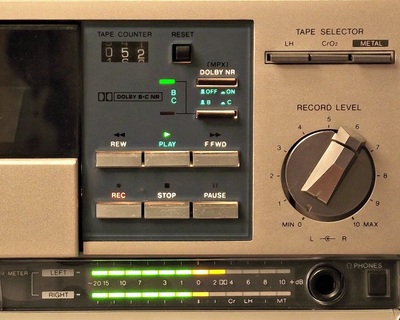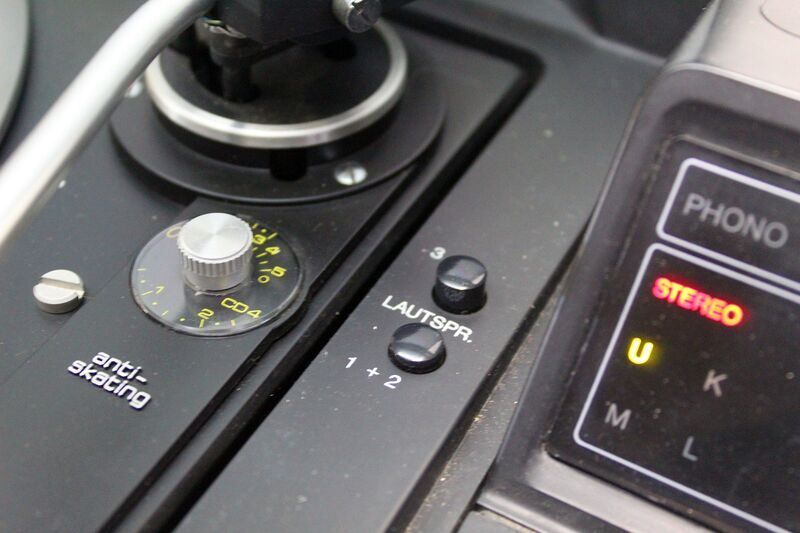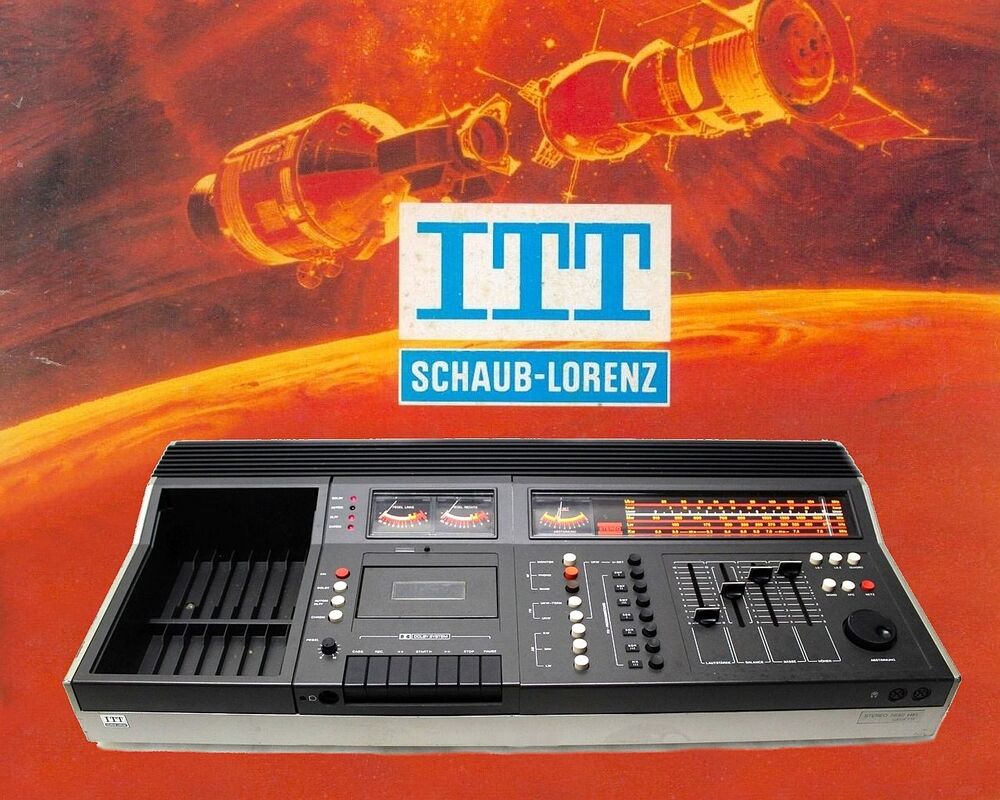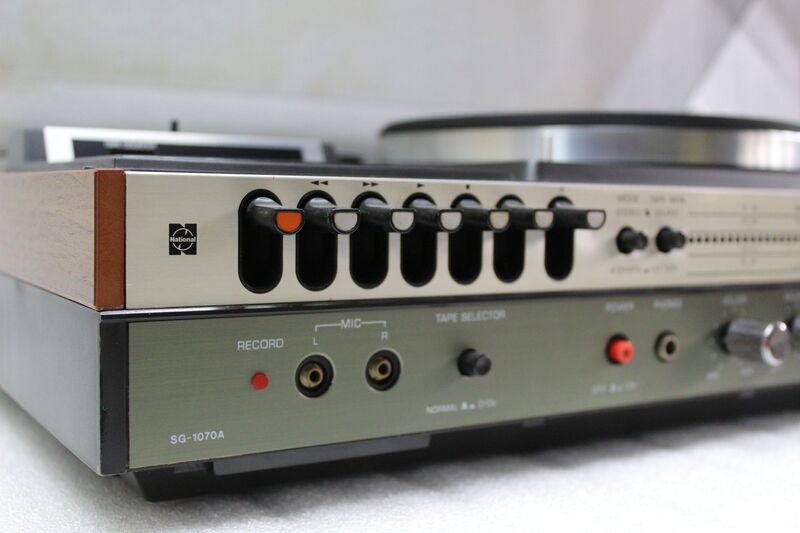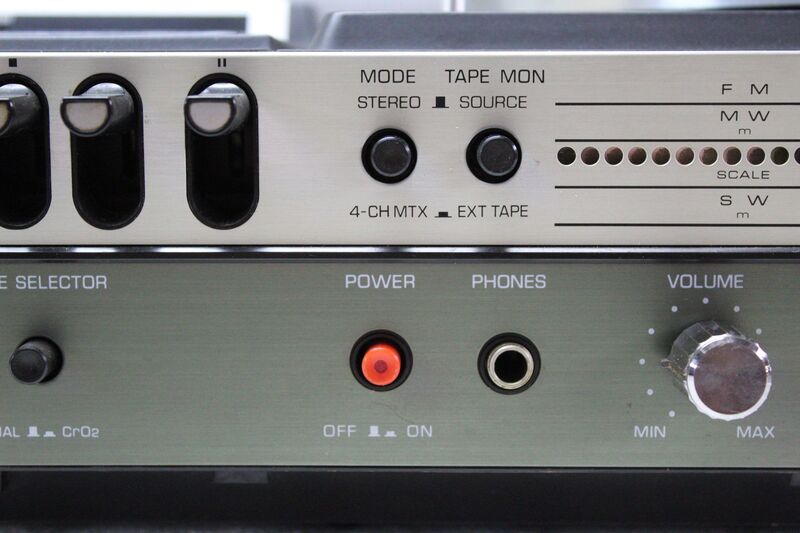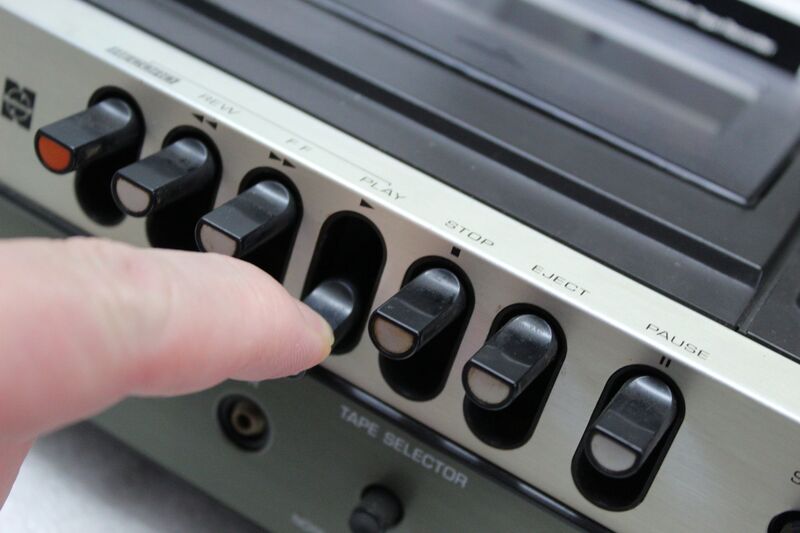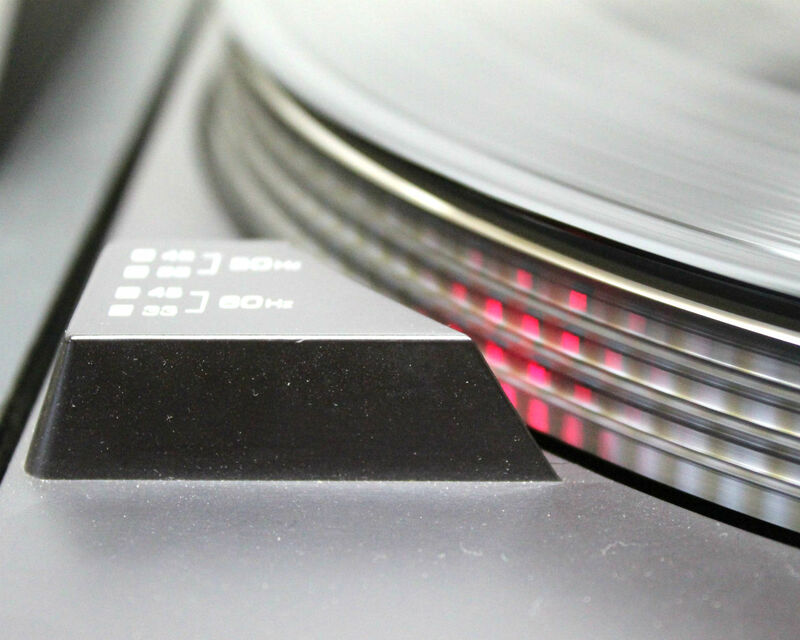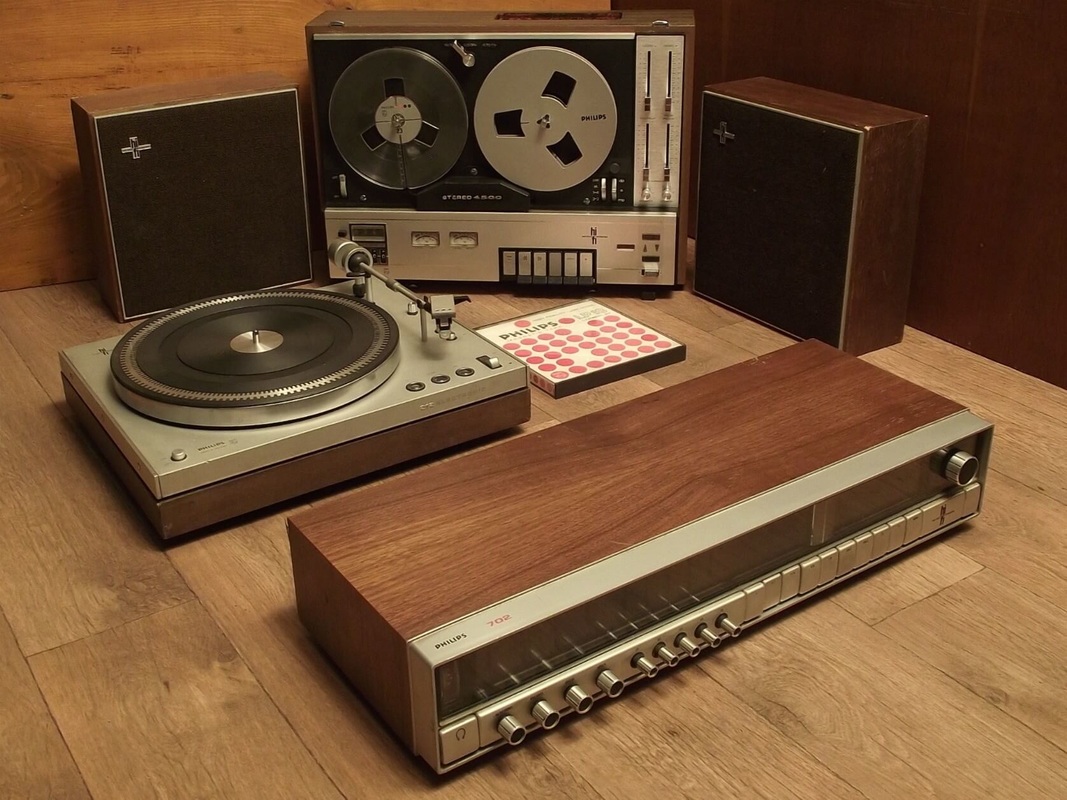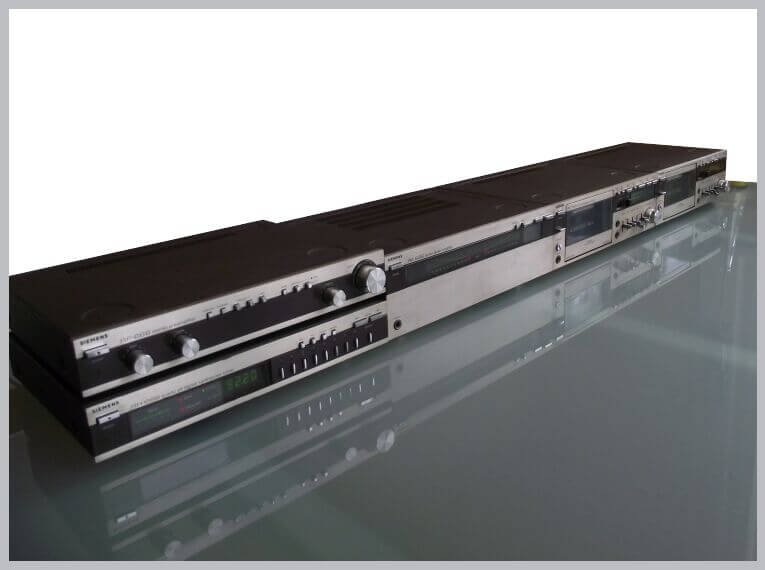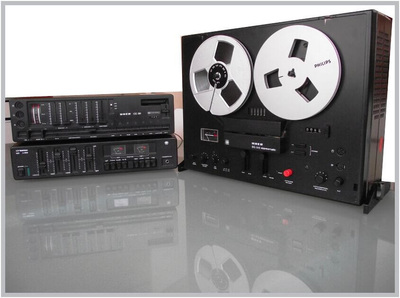SYSTEMS 1971 - 1980
The 1001 Hi-Fi Collection
AIWA MINI SERIES 80/4 (1980)
Top of the line mini-Hi-Fi system from 1980, this is the AIWA "my Pace" series. A high-quality mini system comprised of the following individual mini components: The STEREO CASSETTE DECK L80 - a metal tape capable cassette recorder with AIWA'S special DX HEAD, a dual motor transport and Dolby B and C noise reduction systems. The VU meter is a LED peak program meter similar to the one used in their contemporary 3 head deck the AIWA AD-F660. The FM/MW/LW STEREO TUNER R80 - a digital quartz synthesizer tuner with 6 preset channels. The amplifier section of this mini system was comprised of a pre-amplifier and a power amplifier, just like any other serious full-sized top of the line component. The STEREO PREAMPLIFIER C80 had all the necessary inputs, even a selectable phono input for MM or MC cartridge. Being a mini system, the loudspeakers were small too. In order to compensate for the lack of low frequency output of a small speaker the preamplifier had a two-step low frequency extension circuit called DSL. The matching DC STEREO POWER AMPLIFIER P80 is a 2x50 Watt (8 ohm) "Class A+" construction with a 9 segment LED power indicator.
BLAUPUNKT DIGITA 503 (1978)
The BLAUPUNKT DIGITA 500 Series was introduced in 1978. The modular 500 Series consisted of the following components: DIGITA 501 Receiver, DIGITA 502 C Cassette-Receiver, DIGITA 502 P Turntable-Receiver and the DIGITA 503 Music Center. This was an important product in the Blaupunkt lineup promoted with a dedicated brochure. The heart of the Digita 503 music center is 30W/ch amplifier capable of driving two pairs of loudspeakers (with DIN loudspeaker plugs). There are also front DIN connectors for microphone, tape and headphones. On the left side of the music center is installed a belt drive automatic turntable, the DUAL 1236 A. Dual was a major supplier of turntable chassis that were installed in almost all German made music centers. Not only the turntable was sourced from an external supplier but also the cassette mechanism. This is a slot-in type one motor, two head mechanism (DIGITA C50) from a Japanese manufacturer. Due to the modular construction this mechanism could be retrofitted in the Digita 502 P and Digita 501 components. (The same mechanism can be found in the SABA Ultra HiFi professional 936 from our collection) The cassette recorder offers compatibility with normal, FeCr and Chrome tape formulations, it features automatic and manual record level control (with one peak LED indicator) and Dolby B noise reduction system. The radio section offers reception on all bands, FM Stereo, AM, LW and SW. For frequency display there is a large digital display that doubles as signal strength indicator (FST). Additionally, there is an 8-memory bank for FM presets and another one for 8 AM presets with digital indicator. For easy reference of the preset stations in your memory bank, there is a removable card that could be filled with the station name from a booklet that was delivered with the music center. The booklet contained over 550 European radio station names and frequency. Two different loudspeakers were offered to partner the DIGITA 503 music center, the DIGITA L 50 2-way loudspeaker and the DIGITA L 70 3-way loudspeaker. For free standing placement there was offered a dedicated stand. Size of the DIGITA 503 is 78.5 cm x 16/40 cm x 40 cm (W x H/turntable cover open x deep)
Cover Photo Art: Musica Magica - Published January 15th 2020.
Cover Photo Art: Musica Magica - Published January 15th 2020.
GRAETZ PROFI STUDIO 306 (1975)
The Great Graetz. A big "PROFI STUDIO 306" from 1975, based on their 2 x 50 W (sinus) 2 x 80 W (music) power amplifier. As it was usual with older models, the tone controls are for bass at 40Hz (+/- 18 dB) and for treble at 16 kHz (+/- 18 dB), and there's also a "presence" switch for + 5 dB boost between 3 and 4 kHz. You can connect up to four speakers to the unit, for multiroom operation or a pseudo-quadro sound (Matrix) in one room with the Q-SOUND switch on. The cassette recorder module was made by FG Elektro Geraete (see our deck here) with Dolby performs surprisingly well. The FM radio section has 5 manual presets, and there are 5 pin DIN sockets for two pairs of headphones on the front. For the radio section there are two scales, one for FM and one for AM. Each has a red light on the scale pointer, but only the one on the selected scale lights up. It does this "without wires" using an optical prism system to create the red-light effect in the middle. This amplifier still sounds good today, especially with loudspeakers from the same era.
Last Update: February 2020
Last Update: February 2020
HITACHI SDT-900M (1980)
This HITACHI music center was one of the biggest ever built. Biggest not just in size but in complexity too. It was like having all the top components in one box. The cassette recorder is full logic controlled with two motors, Hitachi's METAL head and manual recording level setting with LED VU meters. It can handle all available cassette types: normal, ferrochrome, chromdioxid and metal. The radio section is a Digital-PLL-Synthesizer-Tuner with 20 memory stations with automatic and manual tuning. The turntable is fully automatic with Hitachi's UNITORQUE direct drive motor with a nice stroboscope (for accurate speed adjustment) visible through a small front window. The amplifier has 2 x 50-watt power (at 1 kHz, 4 Ohm) delivered by two STK084 modules. Volume and balance are electronically controlled and there are two led rows for status display. There are settings for bass, treble and variable loudness control. There was also a built-in digital clock with timer function. The whole unit was operated by a removable - front panel integrated - infrared remote control. The remote can be used for cassette operations, radio station selection, turntable control, volume and balance control and power on/off. Depending on market and year of distribution there were two types of loudspeakers delivered with the unit, the LS-903 and the LS-370. You can see the LS-370 on the LOUDSPEAKER page.
INGELEN HMC 400 (1979)
Another "compact music center" and another one of "Biggest ever". The original model was the ITT HC 9071 that was rebadged as Graetz HMC 400 and this INGELEN HMC 400. This is a completely "feather-touch" controlled music center where everything can be remote controlled using the big "HIFI PROCESSOR" (the remote). There is large vacuum tube fluorescent display for volume / balance / bass and treble control just like for presets and frequency display along with a traditional scale. The turntable from Dual is also a remote controllable model.
ITT Schaub-Lorenz stereo 5650 hifi cassette (1977)
C. Lorenz AG is one of the oldest German electrical and electronics company that was founded in 1880 and was initially located in Berlin. During the 1920 the company was an important radio and valve manufacturer, a primary competitor of Telefunken. In 1930 the company was bought by Standard Elektrizitätsgesellschaft, a subsidiary of the American company ITT (International Telephone and Telegraph) but Lorenz continued to operate independently. It was in 1935 that Lorenz patented the ferrite antenna and besides their radio business they also owned 25% of Focke-Wulf who built some of the most successful Luftwaffe fighter aircraft. In 1958 when ITT reorganized its operations, Lorenz ceased to exist and several companies were merged into Standard Elektrik Lorenz.
Under the name ITT Schaub-Lorenz they continued to build audio-video components and in 1976 it was introduced the Super-Stereo System 600. This was a modular concept and there were several audio system combinations created using the same basic components. In 1977 a new member was added to this system, this was the here presented ITT Schaub-Lorenz stereo 5650 hifi cassette. Based on the same Super-Stereo System 600 components, this music center features a 30W/ch Stereo (pseudo Quad) amplifier and a stereo cassette deck, whereas the new element was the 16-cassette holder compartment. The receiver part with it's 30W/ch amplifier also has a FM-Stereo, AM and SW radio section with 7+1 FM presets. As you can see in the pictures each FM preset has a "badge" with the name of some of the most popular radio stations in Germany. Originally the unit came with number "badges" while the user replaceable radio station badges were delivered as accessory in a bag. The radio section of this unit is very good just like the amplifier. At the back there are inputs for turntable and another tape recorder while due to its modular construction even the systems own cassette recorder is plugged into the amplifier via a external DIN plug. The cassette recorder is a simple, but robust, one motor two head construction with manual and automatic record settings, two VU meters, compatibility with normal and chrome tapes, Dolby noise reduction and a playback only DLPF noise reduction. Somewhat confusing is the fact that there is only one recording level knob but it has two (unlabeled) positions for the two channels, pushed in and pulled out. The matching loudspeaker of this music center was ITT B 600 but for more ambitious Hi-Fi enthusiasts there were also loudspeaker kits available. This music center was available in two color combinations, the here presented one with black control panel and silver box while the other one had inverted colors, silver control panel and black box.
Cover Photo Art: The Controller - Published November 15th 2019
Under the name ITT Schaub-Lorenz they continued to build audio-video components and in 1976 it was introduced the Super-Stereo System 600. This was a modular concept and there were several audio system combinations created using the same basic components. In 1977 a new member was added to this system, this was the here presented ITT Schaub-Lorenz stereo 5650 hifi cassette. Based on the same Super-Stereo System 600 components, this music center features a 30W/ch Stereo (pseudo Quad) amplifier and a stereo cassette deck, whereas the new element was the 16-cassette holder compartment. The receiver part with it's 30W/ch amplifier also has a FM-Stereo, AM and SW radio section with 7+1 FM presets. As you can see in the pictures each FM preset has a "badge" with the name of some of the most popular radio stations in Germany. Originally the unit came with number "badges" while the user replaceable radio station badges were delivered as accessory in a bag. The radio section of this unit is very good just like the amplifier. At the back there are inputs for turntable and another tape recorder while due to its modular construction even the systems own cassette recorder is plugged into the amplifier via a external DIN plug. The cassette recorder is a simple, but robust, one motor two head construction with manual and automatic record settings, two VU meters, compatibility with normal and chrome tapes, Dolby noise reduction and a playback only DLPF noise reduction. Somewhat confusing is the fact that there is only one recording level knob but it has two (unlabeled) positions for the two channels, pushed in and pulled out. The matching loudspeaker of this music center was ITT B 600 but for more ambitious Hi-Fi enthusiasts there were also loudspeaker kits available. This music center was available in two color combinations, the here presented one with black control panel and silver box while the other one had inverted colors, silver control panel and black box.
Cover Photo Art: The Controller - Published November 15th 2019
JVC MF-55LS (1976)
This is a fantastic compact audio system from 1976 made by JVC in Japan. The cassette deck section is a one motor unit with mechanically controlled transport. It has manual EQUALIZER and BIAS selection for Normal, Fe-Cr and Chrome tapes. Recording level is manually adjustable with two needle type VU meters. Instead of Dolby noise reduction this unit uses a JVC proprietary noise reduction system, the ANRS (Automatic Noise Reduction System) and the Super ANRS. The turntable section is a belt drive manual unit with S tonearm and a JVC cartridge. The radio section uses a beautiful acryl tuning scale that stretches across the front edge of the unit. The amplifier delivers 25 W/channel @ 4 ohm. For an external source there is an auxiliary input at the back and there is provision for two sets of loudspeakers, one set for DIN plugs and the other one for bare wire. Featuring only basic components this system still performs great after 39 years (in 2015).
Cover Photo Art: Room Friendliness - Published 15 may 2015
Cover Photo Art: Room Friendliness - Published 15 may 2015
National Panasonic SG-1070A (1975)
This 3-in-1 music center was part of the 1975 line-up from National Panasonic. The full model number SG-1070A means that this was delivered as a complete set consisting of the main unit, loudspeakers and two microphones. The "A" version from our collection features FM-Stereo, AM and SW radio section, idler drive automatic turntable and cassette recorder section with automatic record level setting. There was also a "L" version that was identical except the radio section that had FM-Stereo, AM and LW sections. The amplifier section has a 12 W/ch (4 ohm) power output and features the usual volume, bass, treble and balance controls. The SB-17 loudspeakers delivered with the system are connected to the unit using RCA (cinch) plugs while for the 4 Channel Matrix function the unit is equipped with an extra set of RCA plugs for rear speakers. The system has input for an auxiliary source and an external tape recorder while there is also a set of output (REC OUT) for the external recorder. The AC motor idler driven turntable has a 25 cm platter and will play 33-1/3 and 45 rpm records using the EPC05STAD ceramic cartridge. The unit has a very nice two-tone finish with a dust cover that runs across the whole unit that measures 570x185x368 mm (WxHxD). In order to fully open the dust cover a space of aprox. 45 cm is needed. One of the most striking visual element is the tuning scale. The traditional tuning needle is replaced by an LED that moves behind the perforated aluminium front panel. If you think that this is just a basic music center you are right, but you have to understand that this is a high build quality unit that still works in 2020 after 45 years of its manufacturing date. The only thing that I have replaced was the rubber from the turntable idler tire. The rubber parts of the cassette section need attention too but playback and FF is still functional.
Cover Photo Art: LED's Move - Published March 15th 2020
Cover Photo Art: LED's Move - Published March 15th 2020
National Panasonic SG-5070 (1978)
The National Panasonic SG-5070 "3-in1" Stereo Music Center was introduced in 1978 as an alternative to separate components, but it had the same built quality offered by entry level separates. Here's how the user manual introduced the Music Center to the Music Lover:
"Dear Music Lover
Your new National Panasonic Compact Stereo Phonograph with built-in Radio and Cassette Tape Recorder was manufactured and assembled under exacting quality control standards. The incorporation of the latest advances in design and the use of the most modern components ensure outstanding performance with superb sensitivity and tone quality. Just a few minutes of your time spent reading carefully through this instruction book will assure optimum performance that will bring you continued enjoyment for many years"
Let's take a look at some of the features this National Panasonic SG-5070 Music Center is offering. It features a FM Stereo radio but it also includes MW/LW/SW radio section as well. Usually for optimal FM signal reception you need an external antenna otherwise most likely you'll receive no signal. Not with this unit, this one has a built-in line aerial wire that you can unplug from the antenna socket if you want to use a better external antenna, but you have good reception with this built-in aerial alone. Additionally, there are 6 FM preset pushbuttons with LED indicators. The tuning section of the FM presets is located on the side of the unit behind a flip-down panel. This preset block is using the small frequency dial for tuning and it's located next to the FM center tuning meter. The phono section is a "Classic Technics" design. It features a large-size 30cm Belt-Drive Record player with Frequency Generated Servo DC Motor and accurate stroboscope speed adjustment. The tonearm is equipped with stylus pressure adjustment, antiskating and it was factory equipped with a Moving Magnet type Cartridge (EPC-270C-X). This cartridge is missing from our music center and the one you are seeing in the pictures were borrowed from our JVC MF-55LS (1971). The cassette tape recorder is a one motor "piano key" operated cassette system with auto-stop and compatibility with Normal, CrO2 or Fe-Cr cassette tapes (manual selector). For best recording quality there are separate left and right recording level adjustments, VU meters and Dolby noise reduction circuit. An external tape recorder can also be used via the back panel located DIN socket. The amplifier section has 30 W/ch power output (using a STK461 module), volume, balance, bass, treble controls and Loudness circuit. It has provision for two sets of loudspeakers (DIN plugs) but you can only use one pair at a time. The recommended loudspeakers (sold separately) were the SB-57. The speakers will be automatically disconnected when a headphone is connected to the unit. Dimensions: 683 x 178 x 420 mm (WxHxD) Weight: 14,5 kg.
Cover Photo Art: Music Spectrum - Published May 14th 2019
"Dear Music Lover
Your new National Panasonic Compact Stereo Phonograph with built-in Radio and Cassette Tape Recorder was manufactured and assembled under exacting quality control standards. The incorporation of the latest advances in design and the use of the most modern components ensure outstanding performance with superb sensitivity and tone quality. Just a few minutes of your time spent reading carefully through this instruction book will assure optimum performance that will bring you continued enjoyment for many years"
Let's take a look at some of the features this National Panasonic SG-5070 Music Center is offering. It features a FM Stereo radio but it also includes MW/LW/SW radio section as well. Usually for optimal FM signal reception you need an external antenna otherwise most likely you'll receive no signal. Not with this unit, this one has a built-in line aerial wire that you can unplug from the antenna socket if you want to use a better external antenna, but you have good reception with this built-in aerial alone. Additionally, there are 6 FM preset pushbuttons with LED indicators. The tuning section of the FM presets is located on the side of the unit behind a flip-down panel. This preset block is using the small frequency dial for tuning and it's located next to the FM center tuning meter. The phono section is a "Classic Technics" design. It features a large-size 30cm Belt-Drive Record player with Frequency Generated Servo DC Motor and accurate stroboscope speed adjustment. The tonearm is equipped with stylus pressure adjustment, antiskating and it was factory equipped with a Moving Magnet type Cartridge (EPC-270C-X). This cartridge is missing from our music center and the one you are seeing in the pictures were borrowed from our JVC MF-55LS (1971). The cassette tape recorder is a one motor "piano key" operated cassette system with auto-stop and compatibility with Normal, CrO2 or Fe-Cr cassette tapes (manual selector). For best recording quality there are separate left and right recording level adjustments, VU meters and Dolby noise reduction circuit. An external tape recorder can also be used via the back panel located DIN socket. The amplifier section has 30 W/ch power output (using a STK461 module), volume, balance, bass, treble controls and Loudness circuit. It has provision for two sets of loudspeakers (DIN plugs) but you can only use one pair at a time. The recommended loudspeakers (sold separately) were the SB-57. The speakers will be automatically disconnected when a headphone is connected to the unit. Dimensions: 683 x 178 x 420 mm (WxHxD) Weight: 14,5 kg.
Cover Photo Art: Music Spectrum - Published May 14th 2019
PHILIPS HIGH FIDELITY INTERNATIONAL (1972)
This is a complete Hi-Fi system from 1972. They were all sold as separate components and you had to buy them individually to build your own system using your preferred components. All these components have the "High Fidelity International" logo that was used only on "serious" components made by PHILIPS in the 70's. Units seen in this photo from 2012 are:
PHILIPS STEREO 4500 - 3 head reel to reel recorder (Made in Austria). Read more...
PHILIPS 212 ELECTRONIC - top of the line turntable with PHILIPS M 400 cartridge (Made in Holland) Read more...
PHILIPS 702 - 2 x 12-Watt Sinus amplifier with tuner and presets (Made in Holland) Read more...
PHILIPS 22 RH 402 - 20-Watt 2-way sealed loudspeakers (Made in Finland) Read more...
Tape no.23 that is playing Pink Floyd - The Wall, on the tape recorder is a PHILIPS LP18 (Made in UK) magnetic tape.
PHILIPS STEREO 4500 - 3 head reel to reel recorder (Made in Austria). Read more...
PHILIPS 212 ELECTRONIC - top of the line turntable with PHILIPS M 400 cartridge (Made in Holland) Read more...
PHILIPS 702 - 2 x 12-Watt Sinus amplifier with tuner and presets (Made in Holland) Read more...
PHILIPS 22 RH 402 - 20-Watt 2-way sealed loudspeakers (Made in Finland) Read more...
Tape no.23 that is playing Pink Floyd - The Wall, on the tape recorder is a PHILIPS LP18 (Made in UK) magnetic tape.
PHILIPS Compact-Philetta 861 (1976)
As a result of the grooving popularity of the Compact Cassette, the availability of more and more music cassettes (prerecorded cassettes) in 1976 the PHILIPS Compact-Philetta 861 was introduced as a replacement for the previous 841 model. The 861 has added Chrome tape compatibility and a slightly more powerful amplifier. The amplifier section is specified at 22W total music power delivered by two Hitachi TBA810S-H. According to the technical manual of the TBA810 the maximum power rating is 7W. Typical for the 70's design of these Philips units the Bass, Treble, Balance and Volume control are using these very nice "crystal" transparent sliders. At the front there is provision for microphone input and headphone output (DIN standard plugs) while the two DIN standard speaker connectors and tape/turntable connector can be found at the back of the unit. The radio section has FM-Stereo, AM, LW and SW section. The FM section features automatic stereo decoder and automatic frequency control (AFC). The FM stereo section works really well and is very stable. The cassette recorder section is a very basic one motor mechanically operated system with automatic record level control and no noise reduction. Size of the unit is 43x9x26 cm and the color was called onyx-black by the Philips brochure of the time. Originally the system was delivered with a pair of unspecified model single drive loudspeakers. Since I don't have these loudspeakers, I tested the unit with the RH 402 two-way loudspeaker from our collection. Despite the low power rating the sound is quite rich and pleasant, overall enjoyable. Oh, before I forgot, this unit was Made in Holland.
Cover Photo Art: Stereo 1976 - Published December 15th 2020
Cover Photo Art: Stereo 1976 - Published December 15th 2020
SIEMENS HIFI SYSTEM 666 (1979)
This is one of my favorite systems. It is a micro compact system with genuine HiFi capabilities. It was manufactured in 1979 when the rule was made by BIG HiFi components, so when a manufacturer decided to make a micro component, it had to be really good in terms of sound quality. To achieve this goal for example, all the components have their own power transformers and all have to be plugged to a mains supply. This however is not a "green" solution and does not help the "ease of operation" but is "healthy" for sound quality.
From top to bottom you can see the following components:
SIEMENS RE 666 6 stereo power amplifier - with 2 x 60-Watt sinus DIN 4-ohm power output, MATRIX function for a pseudo QUADRO sound (Price 600 DM in 1980)
SIEMENS RP 666 6 stereo pre-amplifier - with output for active loudspeakers too (Price 450 DM in 1980)
SIEMENS RH 666 6 quartz synthesizer tuner with digital display and 8 station memory (Price 650 DM in 1980)
SIEMENS RC 666 6 microprocessor controlled HiFi cassette deck with metal frequency response 30-18.000 Hz
The additional 6 in the model number is for the brown/bronze color scheme.
The above-mentioned system was the "standard factory system" but for my system I have a second
cassette deck and the SIEMENS RL 706, 3 Way loudspeaker system of 140/100 Watt music/sinus power.
All the components were Made in Japan and are in fact rebadges of the SANYO Plus P 20 (power amplifier) Plus C 20 (pre-amplifier) Plus T 20 (tuner) and Plus D 20 (cassette recorder)
From top to bottom you can see the following components:
SIEMENS RE 666 6 stereo power amplifier - with 2 x 60-Watt sinus DIN 4-ohm power output, MATRIX function for a pseudo QUADRO sound (Price 600 DM in 1980)
SIEMENS RP 666 6 stereo pre-amplifier - with output for active loudspeakers too (Price 450 DM in 1980)
SIEMENS RH 666 6 quartz synthesizer tuner with digital display and 8 station memory (Price 650 DM in 1980)
SIEMENS RC 666 6 microprocessor controlled HiFi cassette deck with metal frequency response 30-18.000 Hz
The additional 6 in the model number is for the brown/bronze color scheme.
The above-mentioned system was the "standard factory system" but for my system I have a second
cassette deck and the SIEMENS RL 706, 3 Way loudspeaker system of 140/100 Watt music/sinus power.
All the components were Made in Japan and are in fact rebadges of the SANYO Plus P 20 (power amplifier) Plus C 20 (pre-amplifier) Plus T 20 (tuner) and Plus D 20 (cassette recorder)
SONY HMK-80B (1979)
For those who wanted hi-fi sound without the inconvenience of having three or four separate units to be connected together SONY offered a wide range of music centers. The SONY HMK-80B introduced in 1979 is a perfect example of a well-built music center. While visually identical with the HMK-77B from 1977 sharp eyes will notice that this HMK-80B has added FM presets. Right at the first contact with the unit there is a tactile feeling of a quality component with precise aluminum turn knobs, a nice brushed aluminum front panel and wood side panels. The turntable section uses a Direct Drive (DC servo) turntable with S-shaped tonearm complete with a removable magnesium headshell fitted with a SONY VL-34G moving magnet cartridge. The tuner section had all the wavelengths such as SW, LW, MW and FM Stereo with five presets for which the tuning knobs were located on the side of the unit. The cassette recorder is a basic piano key controlled one motor unit that uses Sony's own F&F (Ferrite&Ferrite) heads - Sony's best heads of the moment. Instead of the usual automatic level control the recorder is fitted with separate left-right manual recording level control with two VU meters and a peak level LED. Recordings can be made using Normal, FerriChrome or Chrome tapes with or without the use of the Dolby B noise reduction circuit. The amplifier section is a very nice sounding 35 W/ch (8 ohm) construction with a fine stepped volume control featuring bass, treble and loudness tone controls, high filter and an additional tape input. This input you can still use today to connect a computer or a portable player (smartphone) to the music center. The original sale price of the unit was 989 DM and that's approximately the same amount of money you had to pay for a set of entry level separate components from the same manufacturer. Size of the unit: 663(W) x 177(H) x 495(D) mm and it weighs 19.3 kg.
Cover Photo Art: The Color of Music -Published May 15th 2017
Cover Photo Art: The Color of Music -Published May 15th 2017
UHER "SYSTEM 1" (1976)
"Faszination Deutschland" could be the name of this system. All the components have the typical 1970's german design elements, all in black (even if the amplifier is Japanese) and they all use DIN standard plugs. They look all well together and they perform very well too. To build such a system you had to buy all the components individually so they best suit your taste. You can see all the components presented individually in detail in their category. Just click the model in the list.
The system has the following components:
UHER SG 510 stereomatic tape recorder from 1975
UHER CG 361 stereo autoreverse cassette deck from 1976
Teleton a 300 amplifier from 1976
The system has the following components:
UHER SG 510 stereomatic tape recorder from 1975
UHER CG 361 stereo autoreverse cassette deck from 1976
Teleton a 300 amplifier from 1976
WEGA STUDIO 3214 HiFi (1972)
Big (huge) music center from a time when WEGA had a German design with German electronics made in Stuttgart. Later WEGA became a SONY brand, making many SONY products under WEGA name. Despite the fact that it is a big unit, it has a well-balanced design. In terms of sound quality this is a high-quality music center. It has a 2 x 30 W SINUS amplifier and a very good FM radio with 7 station memory. The turntable is a DUAL 1218 model with SHURE DM 101 MG "high track system" cartridge. This can also operate as a 6 vinyl LP changer, and all this was yours in 1972 for 1880 DM. (Deutsche mark)






